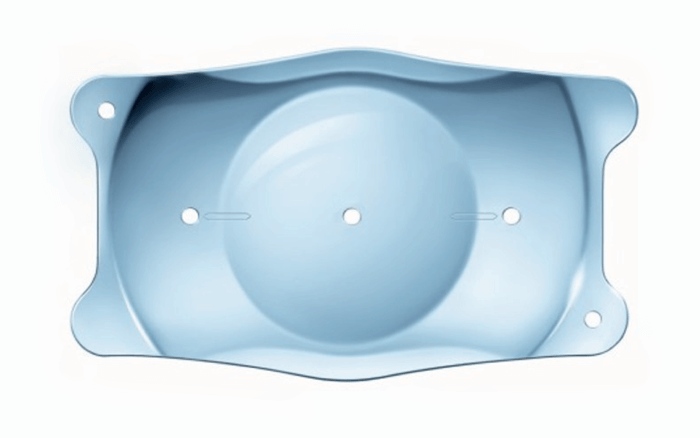

How does lens-based refractive surgery compare with other available options?
Vukich: As a refractive surgeon, I want to have all of the available tools in my armamentarium, so the patients’ needs are better served. The outstanding global experience with ICLs has established that they are not only an excellent optical solution, but also a very safe option.
Bruns: From my optometrist perspective, modern ICLs provide a great treatment option for our patients. The procedure does not disrupt the corneal tissue and the ICL is totally removable. Because the corneal tissue is left intact, patients may have more options available when it’s time for cataract surgery later in life. It is also a great procedure for patients with a history of dry eye syndrome or surface irregularities.
What changes have you been observing in the field of lens-based refractive surgery?
Vukich: These days, all lens-based surgery aims to correct the refractive error. In the case of cataract surgery, it is very rare that the surgeon and the patient would not discuss the desired refractive outcome, and the ability to achieve it using high-technology lenses that either correct astigmatism or provide depth of focus or multifocality. There is also now an understanding that the intraocular space is the ideal location for refractive correction, so ICLs have certainly gained momentum, as more surgeons have also become aware of the selection of lens sizes. ICLs are a perfect example of how a good procedure gains recognition over time through the weight of available data, which continually show excellent outcomes.
I see how the ICL market has grown simply by word of mouth. There was a temporary pause during the early pandemic lockdowns, but the pent-up demand is now really coming to bear. With the recent approval of the EVO ICL in the US, surgeons are taking note of the new technology and the latest upgrade to the Visian Family of ICLs. The EVO ICL is available to be used in a wide variety of patients, with a great margin of safety!
Bruns: We’re seeing growing numbers of practices offer ICLs. They help us offer patients a whole spectrum of options, with one or more available to them. Laser vision correction is a good option for many patients, but I anticipate ICL surgery being much more front of mind for a larger percentage of doctors and patients in the coming years, especially with the approval of the EVO ICL in the US.
Which phakic IOLs do you use in your practice and why have you made this choice?
Bruns: Our surgeons exclusively use the EVO Visian ICL from STAAR Surgical. We find that – based on where the lens is placed within the eye – the EVO ICL delivers terrific optical performance and gives excellent visual outcomes, especially for moderate to high myopes. The idea that it’s removable is also appealing. It would be very rare for our practice to remove a lens, but simply knowing that this is an option is comforting for patients, especially those who dislike the idea of a laser-based refractive procedure.
Vukich: The EVO Visian Collamer® material has proved itself to be exceptionally biocompatable. The ICL not only achieves excellent quality of vision; our experience demonstrates that the results are sustainable over decades. With STAAR Surgical ICLs, we have in excess of 20 years of data, which makes me very confident that this lens is not only very well tolerated, but it also maintains excellent optical quality in the long run.

What impact has the use of ICLs had on your practice and what results have you seen?
Vukich: In my view, it is challenging to be a comprehensive refractive-based surgeon and not be offering ICLs. The lens has been an important part of my practice since the initial clinical investigations, and it is a great solution for many of my patients. The ICL has provided a dramatic improvement in quality of life for so many patients that I can’t imagine not offering that option.
Bruns: The results have been just amazing: the visual quality with the ICL is much better than I expected it to be. Having patients in the double digits in the myopic range who are seeing 20/15 just a few days after surgery is pretty jaw dropping! The results are truly life changing for these patients.
Are you planning to increase the use of ICLs in the practice?
Bruns: Absolutely! Most of our patients find us on their own; we don’t even have to do a lot of marketing for the ICL right now, and we’re seeing that this part of the practice has grown significantly, especially over the past year or so. Partly due to the pandemic, we’re finding a lot more patients seeking out options to get rid of glasses, and ICL has been a huge part of that. To give them the ability to see so well again without glasses or contacts is very rewarding.
For more information about the benefits and risks of the EVO Visian ICL, please refer to the DFU available here
Important Safety Information for the Visian ICL Product Family:
The EVO Visian ICL is indicated for phakic patients 21-45 years of age to correct/ reduce myopia with up to 4.00 D of astigmatism with a spherical equivalent ranging from -3.00 to -20.0 D and with an anterior chamber depth (ACD) 3.0 mm or greater.
The EVO Visian ICL is contraindicated in patients with a true ACD of <3.00mm; with anterior chambwer angle less than Grade III; who have moderate to severe glaucoma, who are pregnant or nursing; less than 21 years of age; and who do not meet the minimum endothelial cell density (ECD) listed in the Directions For Use (DFU).
A summary of the relevant warnings, precautions and side effects: Endothelial cell loss, corneal edema, cataract, narrowing of the anterior chamber angle, pupillary block, increased intraocular pressure, glaucoma, secondary surgery to reposition, replace or remove the ICL, loss of BSCVA, increase in refractive astigmatism, glare and/or halos, pigment dispersion, iris transillumination defects, endophthalmitis, hypopyon, corneal endothelial damage, ICL dislocation, cystoid macular edema, iritis, retinal detachment, vitritis, and iris prolapse.
Please review the DFU for complete safety and other information before performing the clinical procedure.
References
- M Packer, “United States multicenter clinical trial of a posterior chamber phakic implantable lens with a central port for myopia or myopic astigmatism,” Presented at ASCRS Annual Meeting; April 24, 2022; Washington, DC, USA.
- E Martínez-Plaza et al., „Effect of the EVO+ Visian phakic Implantable Collamer Lens on visual performance and quality of vision and life,” Am J Ophthalmol, 226, 117 (2021). PMID: 33577790.
